Gerónimo Antonio Gil
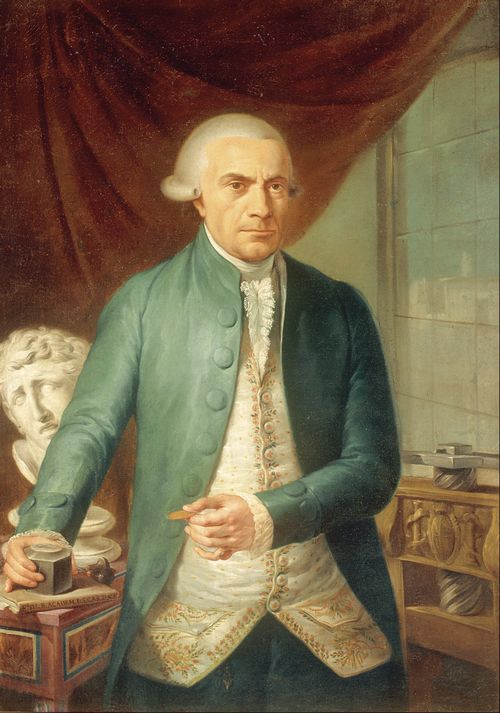
Gerónimo Antonio Gil holds a medal and a stamp, below which are the statutes of the Academy of San Carlos.
The change to the Mexico Mint in 1772 caused problems as the engravers and carvers, Antonio Cervantes, Luis Gómez, Francisco Casanova, Alejo Bernabe Madero, Juan Fernández de la Peña and Francisco Monllor, were unable to adjust and perfect the tooling of the new coinage. For this reason, Charles III ordered improvements in the training of engravers, allocating more personnel and resources to the Mexico Mint, especially its engraving office. Although problems persisted, this was a first precedent for the future creation of an academy.
The golden age of engraving began with the work of Gerónimo Antonio Gil who came to serve as Engraver at the Royal Mint of New Spain, replacing Francisco de Casanova (other authors say that he was really intended to replace Alejo Bernabé Madero -titular engraver at the Casa de Moneda who due to eye fatigue had practically been relieved by the honorary engraver Francisco Casanova).
Gerónimo Antonio Gil was born in Zamora, Spain on 2 November 1731. He was a distinguished student of the prestigious Tomás Francisco Prieto, engraver at the Madrid Mint and entered the Royal Academy of Fine Arts of San Fernando in 1760. He specialized in engraving medals and coins. He made the punches and matrices for the typeface of the Royal Library of Madrid, engraved several seals and made the plates for several printed works, numerous medals and a portrait of King Charles III.
In 1778 Gil was appointed chief engraver at the Mexico City Mint (Real Casa de Moneda de México) and from the beginning was entrusted with the important task of establishing a school of engraving, a project that became a reality on 25 December 1781, when Carlos II, by means of a Royal Provision, created the Real Academia de Nobles Artes de San Carlos de la Nueva España (the three noble arts were painting, sculpture and architecture) (later it changed its name to Academia de Bellas Artes de San Carlos).
Gil was accompanied to Mexico by his two sons, Gabriel and Bernardo, as well as Tomas Suría and José Esteve, all of whom would work as engravers. On Gil’s arrival in 1778, the Spanish military engineer Miguel Constansó was entrusted with the remodelling of the Mint to accommodate the lower carving offices, the Academy of Drawing and the Museum. The first medals were minted in the facilities of the mint, next to the National Palace, today the Museo Nacional de las Culturas.
In 1789 Gil was appointed Faithful Administrator (fiel administrador), so that in addition to engraving he had under his direction the foundry, refining of metals and minting of the coin. He held these functions until his death on 18 April 1798.
Gerónimo Antonio Gil was definitely the most productive of the engravers, with more than 70 medals of his authorship, and having created 6,000 to 8,000 punches and dies.
He designed several of the most beautiful medals in New Spain. The first of these, dated 1778, is a medal of proclamation of Charles III, minted in gold, silver and bronze.
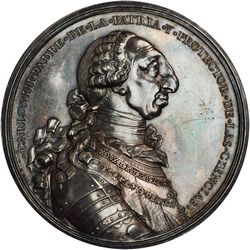

K075a Spanish Royal Academy of Law (Real Academia de Derecho Español) Silver Medal, 1778 (Stack's Bowers NYINC January 2015 auction, lot 1036)
The obverse depicts the bust of the king richly dressed and wearing the collar of the Order of the Golden Fleece. The reverse shows a figure seated at a table on a pedestal, surrounded by four female figures dressed in Roman togas (representing fortitude, temperance, prudence and justice), one of whom is about to crown the first with laurel. Below the pedestal, two male figures contemplate the scene. The caption reads: "Charles III, father of the country and protector of the sciences. The most prudent wins and triumphs." This allegory of victory is a faithful reflection of the neoclassical style that Gil would impose as a norm in the Academy of San Carlos. The Mexico City "Mo" mint mark is visible at 8 o'clock on the reverse very neatly hidden on a rock.
Two varieties of this medal exist, the first with the obverse die signed "G. A. GIL.", the second simply "GIL". The medal illustrated is the first and rarer of the two medals, of which only 154 pieces were struck before the obverse die broke and was replace with the die signed "GIL".
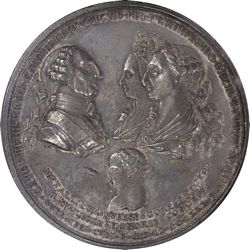
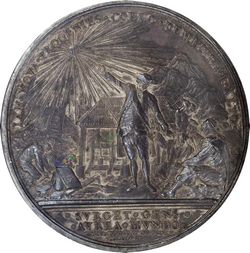
K-82a Silver Proclamation 8 Reales (Stack’s Bowers Auction, 27 February 2020, lot 71211)
To celebrate the birth of Prince Ferdinand in 1784, the group of miners of Mexico dedicated a medal to him, which was designed by Antonio Gil in 1785. The obverse depicts the right-hand bust of King Charles III, facing the Prince and Princess of Asturias (Charles – the future Charles IV – and Maria Luisa), who are seen in left profile. Below them is Prince Ferdinand, the ninth son of Charles IV and who would come to the Spanish throne in 1808 under the name of Ferdinand VII, also in left profile. The perimeter reads in Latin: "Charles III King of Spain. Carlos and Luisa, children. Fernando, the most recent offspring." On the reverse is a scene illustrating the work of the mining guild.
In 1788 Gil designed a funeral medal for the death of Charles III. The obverse shows the profile of Charles III in advanced age and dressed in the manner of the Order of the Golden Fleece. On the perimeter it reads in Latin: "Charles III King of Spain and the Indies. The Mexican Academy to its founder." On the reverse is the king's tomb surrounded by the legend in Latin: "Who revived the liberal arts"; in the exergue we read: "Dead shall be loved."
In 1790 Gil designed a proclamation medal of Charles IV dedicated to the miners of the city of Guanajuato. This medal is considered one of the most beautiful of the colonial period. Its obverse has two varieties: the first shows the profile effigy of Charles IV, while the second shows him accompanied by Queen Maria Luisa. On the reverse side you can see the interior of a mine, in which a group of miners are in charge of different tasks. The caption reads: "Acclaimed in the city of Guanajuato by his loyal miners." In the exergue the date is seen: "October 23, 1790."
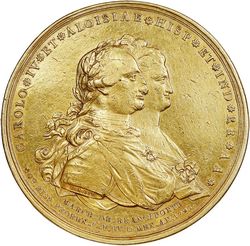

C267 El Caballito gold medal, 1766 (Stack’s Bowers NYINC Auction, 13 January 2024, lot 53144)
Finally, the masterpiece in Gerónimo Antonio Gil's career as an engraver is the medal known as "El Caballito", which reproduces the equestrian statue of Charles IV created by Manuel Tolsá and which is currently located in the square of the same name in Mexico City. On the reverse of the piece you can see the profile reproduction of the aforementioned statue. The obverse shows the profile busts of Charles IV and his wife; on the perimeter it reads in Latin: "Charles IV and Louise Kings of Spain and the Indies". The piece is signed by both Gil and Tolsá. The chronicles of the time say that when Tolsá's sculpture was inaugurated in 1802, three thousand of the silver medals engraved by Gil were thrown from the balconies.
